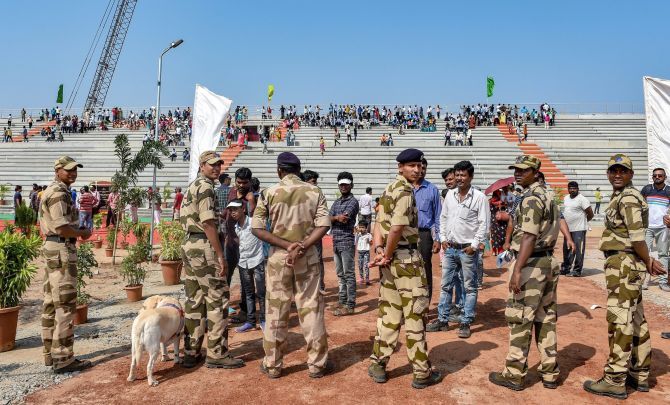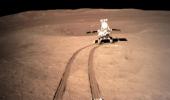India scripted history by successfully launching EMISAT, a military satellite, and 28 foreign nano satellites on-board its polar rocket from Sriharikota on Monday, in a complex mission which marked many a first for Indian Space Research Organisation.

The rocket, PSLV-C45, in its 47th mission, injected the 436 kg EMISAT, aimed at electromagnetic measurement, and 28 co-passenger satellites belonging to Lithuania, Spain, Switzerland and the United States, into their designated orbits, ISRO said.
The rocket lifted off majestically in clear skies bursting orange flames at 9.27 am from the second launch pad at this spaceport at the end of the 27-hour countdown.
The mission marked several firsts to the credit of ISRO as it manoeuvred satellites in various orbits and orbital experiments including on maritime satellite applications.
EMISAT is meant for electromagnetic measurement, ISRO said while declining to reveal any further information about the satellite.
Prime Minister Narendra Modi congratulated ISRO scientists on the successful launch of EMISAT satellite on board polar rocket PSLV-C45 from Sriharikota.
"Today, PSLV C45 has successfully injected ISRO made EMISAT in 748 km orbit as well as 28 customer satellites in 504 km orbit," ISRO chief K Sivan said at the Mission Control Centre.
"After completing its main function, the PS4 (fourth stage) is now marching towards the 485 km orbit to do its function as orbital platform for experiments," he said.
WATCH: 5... 4... 3... 2... 1... It's a lift-off!
Elaborating, Sivan said, "this time three innovative experiments have been attached. One is AMSAT (Radio Amateur Satellite Corporation, Automatic Identification System, and the third one is built by the students of Indian Institute of Space Science and Technology."
On Monday's launch, he said this particular mission was very special for ISRO as there were many firsts in it.
"First time a PSLV was flown in a new configuration of four strap on motors... first time a PSLV is carrying out three orbital missions in a single flight, the first time PS4 (fourth stage) is powered for carrying out experimental platforms and of course a new PSLV team did this function," he said.
WATCH: PSLV-C45 mission is very special for ISRO chairman
Congratulating the team on the successful launch, Sivan said, "Enormous amount of work is behind this excellent success... the work is really contributed by each and every one of the ISRO team members. Let me complement and congratulate ISRO team members as well as their family members for making this particular mission a grand success."
Noting that the industry played a major role in the PSLV-C45 mission, he said, nearly 95 per cent of the hardware for this mission was fabricated outside ISRO, that is industry.
"Nearly 60-70 per cent of the satellite components were fabricated outside ISRO. In fact the payload for this particular satellite is fabricated in one of the electronic industries in Bengaluru," he said and thanked the industries for providing help.
On the future missions lined up for ISRO, he said after completing all these wonderful missions, ISRO was scheduled to launch 30 missions by the year end.
"There is a lot of work for my team. Immediately, by mid May we are going to have PSLV C46 that is going to launch RISAT 2B, followed by PSLV C47 which is going to launch CARTOSAT-3 satellite, then we are going to have Chandrayaan II and so on," he said.

PSLV, also used in India's two key missions -- "Chandrayan" in 2008 and Mars Orbiter in 2013, is a reliable and versatile launch vehicle for ISRO with 39 consecutive successful flights till June, 2017 and five-in-a row from January 2018.
In Monday's mission, ISRO scientists placed the satellites and payloads in three different orbits.
After injecting the primary satellite EMISAT around 17 minutes from lift off in a 748 km orbit, they restarted the fourth stage twice.
During this initiative, all the other 28 customer satellites, totally weighing about 220 kg, were released one-by-one by lowering the fourth stage to around 504 km orbit. "This process took about 160 minutes for ISRO from lift off at 9.27 am," an official said.
Again, the fourth stage was reignited and further lowered to 485 km orbit to serve as an orbital platform for carrying out space borne experimentations for the first time in ISRO's history.

This is the first time it has been envisaged to provide a micro-gravity environment for research organisations and academic institutes to perform experiments, ISRO said.
The experiment payloads are automatic identification system from ISRO for Maritime satellite applications capturing messages transmitted from ships.
Automatic Packet Repeating System from AMSAT (Radio Amateur Satellite Corporation), India to assist amateur radio operators in tracking and monitoring position data.
Advanced Retarding Potential Analyzer for lonospheric Studies (ARIS) from IIST for the structural and composition studies of ionosphere.
The other 28 international satellites -- 25 3U type, two 6U type and one 2U type nano satellites -- are from Lithuania (two), Spain (1), Switzerland (1) and the United States (24).
All these satellites were launched under commercial arrangements, ISRO said.











 © 2025
© 2025